My life as a Juvenile Detention Officer..BECCA BILL..Rebecca Hedman 's Story
Rebecca Hedman's story is one that has had a huge effect on both youth and their parents in Washington State. The Bill Was presented by Rebecca's parents in hopes that it would give parents more rights when their children were runaway, however in my observations , it gives the law more leeway to put more youth in the system and gives CPS an open law to take youth out of their homes and place them either in fostor care or Juvenile Detention simply for skipping school.
The Rebecca Hedman Story

Rebecca Hedman was a 13 year old Tacoma, WA runaway. She was prostituting herself to support her crack addiction when she was picked up by John Medlock who bludgeoned her to death with a baseball bat and dumped her body. It was revealed that prior to this, Rebecca’s parent’s went to the Juvenile court telling them their daughter was out of control and they were looking for help. The courts said they were unable to help unless she had committed a crime. The outrage that was involved with this case raised a lot of questions about runaways and parental rights and so The Becca Bill was created as a response. This Bill states in part,
“… children between 8 and 18 are required to attend public school regularly, with few exceptions…students and parents can face serious consequences if a student has too many unexcused absences… students can be referred to juvenile court and ordered to serve time in juvenile detention. Parents will be fined.”
This is the tragic story of a lost little girl and the parent’s that didn’t know what to do. With all good intentions, this bill was designed to protect children who are endangering themselves.
http://www.becausewecamp.com/becauseweblog/the-becca-bill-and-me
Washington's Becca Bill: The Costs of Empowering Parents
Abuse was the pervasive theme of Washington teen Rebecca Hedman's short life. "Becca," as she was known by her family, was sexually abused by her natural mother. At the age of fifteen months, Becca was placed in a foster home with the family that eventually adopted her, the Hedmans. When she was five years old, Becca was sexually abused by her older adopted brother. Her adoptive family provided her with counseling to cope with her abusive past, and at the age of twelve, she seemed to be adjusting well. In middle school, however, Becca became involved with the "wrong crowd" and began to rebel. Unable to handle her, her parents sent her to a state-run Crisis Residential Center and then to a group home. At the group home, Becca met older girls who introduced her to crack cocaine, prostitution, and a life on the streets. After running away from the group home for forty-seven days, Becca returned home to her parents. They enrolled her in drug counseling and, for a short time, she appeared to be getting her life together. Her parents, still concerned about her drug habit, sent her to a residential drug counseling clinic in Spokane, Washington. They were under the impression that the staff of the clinic would call if she ran away from the clinic. However, Becca ran away from the clinic five times and her parents were never notified.
In October 1993, during one of her runaway periods, Becca was picked up on a Spokane street comer by a thirty-five year old man who paid her fifty dollars for sex. Because Becca did not adequately satisfy the man, he became enraged and demanded a refund. When she refused, he grabbed a baseball bat and hit her in the back of the head six times, killing her. He dumped her body in the Spokane River.' It was Becca's short life and tragic death which spawned Washington's new legislation regarding runaway youths and the parents who want to control them. Appropriately nicknamed the "Becca Bill," Senate Bill 5439 became law in Washington in July 1995.2 The Becca Bill is the Legislature's attempt to accommodate frustrated parents' demands for control over their children's lives. It provides for detainment and court intervention into the lives of juveniles known as "status offenders." Unlike juvenile delinquents, status offenders fall within the jurisdiction of the juvenile court for actions which would not be criminal if committed by an adult.3 This Comment gives a practical overview of the Becca Bill and its provisions and addresses the potentially dangerous ramifications of the bill. Part II of this Comment gives a brief history of the trends in juvenile justice in this country, establishing a context for what led to the Becca Bill's passage. Part II also introduces the Juvenile Justice and Delinquency Prevention (JJDP) Act of 1974, the first federal act to mandate the deinstitutionalization of the status offender.
Part III of this Comment gives a brief history of Washington's statutes dealing with status offenders. This section then outlines the key portions of the Becca Bill, focusing primarily on the "lockup" provision and new petitions available to parents in order to obtain court intervention into the lives of their unmanageable children. Part III also briefly discusses controversial portions of the Becca Bill that were vetoed by Governor Lowry, as well as alternative bills that were before the Washington Legislature. Part IV of this Comment addresses potential problems with the Becca Bill as enacted. This section discusses how the Bill is working, one year after its passage, based primarily on reports by practitioners who are attempting to carry out the law. Part IV then addresses concerns about the potential loss of federal funding under the JJDP Act of 1974, and discusses the extent that federal dollars provided to Washington for enacting juvenile justice programs are placed in jeopardy by the Becca Bill. Part IV also examines the practice of "bootstrapping" juvenile status offenders into the criminal justice system through the bill's contempt of court provisions.
This Comment concludes that not only is the Becca Bill not working in practice, but that it represents a dangerous trend back to the days of parens patriae and excessive court intervention into the lives of noncriminal youths. Close watch should be placed upon our Legislature to ensure that even stronger laws to control noncriminal juveniles are never passed, as well as to ensure that valuable federal dollars are not further jeopardized. Additionally, advocates for children's rights should be watchful that contempt provisions, now more accessible to parents through the Becca Bill, are not used as away of bootstrapping a child into the criminal justice system.....
The “Becca Bill” 20 Years Later: How Washington’s Truancy Laws Negatively Impact Children
BY SARAH LIPPEK AND STARCIA AGUE
Becca is a girl’s name many of us know because of the “Becca bill,” a piece of legislation in Washington State named for a young girl who was murdered. Twenty years after her death, the law that was passed in Becca’s name has incarcerated thousands of children who were never found guilty of any crime. The Becca laws have made Washington State the country’s foremost jailer of children for “status offenses” like skipping school, coming
home after curfew, and not doing their homework or household chores. The Becca bill was passed in the wake of a terrible and tragic murder, and passed with good intentions to keep kids like Becca—who was known as Misty among her friends on the street—safe. But intentions are complicated, and the best intentions sometimes lead to
the cruelest results. Now we can see the effects. The law now allows parents to use legal petitions called ARY (At Risk Youth) to obtain court orders that require children to participate in social services, to attend school, and to obey their guardians. Kids who disobey these court orders can be found in contempt and jailed. In a single year, Washington State judges ordered young “status offenders” into juvenile detention a total of 2,705 times. The only state that came close to that number is Kentucky, with less than half as many orders. These orders have not done what they were intended to do. In some cases, they have become a tool for parents to control their children through the courts, by adding jail time to the list of potential punishment. No statistical correlation has been found between ARY petitions and high school enrollment. This is because poverty—not insufficient parental authority—is the primary cause of truancy. Poverty imposes on children all the dynamics and consequences of material and emotional deprivation. Ned Lauver, an associate school principal writing in Educational Leadership, finds a very strong correlation between poverty and chronic absence: “Poverty and school absence or truancy often feed each other. The conditions that students living in poverty face (poor nutrition, lack of access to health care, even a lack of gas in the car at month's end so that a child who misses the bus can't catch a ride) exacerbate poor attendance.” The Becca law also makes things much harder for children who are already laboring under social stigma and racism. According to the Washington State Institute for Public Policy, children under Becca orders are disproportionately poor, and also disproportionately from groups the state calls racial or ethnic minorities. When folks talk about the “school-to-prison pipeline,” this is precisely the mechanism they are talking about. Children who are read as white, who are outwardly compliant, whose families have resources, and who can keep their teenage rebellions behind closed suburban doors are treated very differently than children who do not have these options. That leads to the state-imposed criminalization of certain children. These children are not just chided, corrected, or lectured for their behavior. They end up in jail, dramatically increasing their chances of entering the adult criminal system and exacerbating the deep-rooted inequities in the Washington State prison system—and the racial disproportions of the U.S. carceral system as a whole. As momentum builds nationwide toward creating less punitive juvenile justice systems, it is time to examine our truancy laws. We should not be jailing young people instead, we should work to understand the underlying causes of their behaviors. This will allow us to develop the tools and resources kids will need to thrive at home, in their schools, and in their communities.
file:///C:/Users/Ann/Downloads/The_Becca_Bill_20_Years_Later_How_Washingtons_Truancy_Laws_Negatively_Impact_Children.pdf
Washington No.1 for jailing noncriminal kids, spurred by law named for Tacoma runaway
BY MELISSA SANTOS
Staff writer, http://www.thenewstribune.com
July 13, 2015 10:26 AM
Updated January 31, 2016 06:57 PM
More than two decades after the beaten body of a Tacoma runaway was found along the Spokane River, a photo of her hangs prominently on the wall in a King County juvenile courtroom.
It’s the same photo Rebecca Hedman’s parents took to Olympia 20 years ago to push lawmakers to pass the Becca Bill, which gave parents more authority to seek help for their runaway children.
Yet today, critics say the law passed in the 13-year-old’s memory does more harm than good. It is the main reason Washington leads the nation in the number of times judges send children to jail for noncriminal offenses, such as skipping school or running away.
Becca’s mother and father, Darlene and Dennis Hedman, now say the law isn’t working as they intended: as a way to connect troubled children with resources and professional help. Some say that’s partly because the Legislature hasn’t provided enough funding for detention alternatives.
The Becca Bill lets judges in Washington place kids in juvenile detention for repeatedly skipping school, breaking curfew or running away from home — actions known as status offenses, which wouldn’t be illegal for anyone 18 or older.
In 2011, the most recent year for which federal data is available, judges in Washington ordered status offenders to spend time in juvenile detention 2,705 times, more than twice as often as any other state.
Kentucky, the No. 2 state for detaining juveniles for status offenses that year, did so only 1,048 times — and has since changed its law to discourage the practice.
Some state lawmakers and youth advocacy groups say it’s time for Washington to change its law, too.
Already, several counties in Washington are pursuing alternatives to detaining teens who appear in court for noncriminal offenses such as truancy. Yet statewide, the number of times judges order youth to spend time in detention for disobeying court orders in those types of cases remains high.
Critics of Washington’s system say sending kids to up to seven days of detention for repeatedly skipping school or running away hasn’t been shown to change their behavior and can actually traumatize them instead.
“We use it too frequently,” said state Sen. Jeannie Darneille, D-Tacoma. “It’s harmful, and it’s costly.”
Darneille and others worry especially about effects of detaining youth whose worst offense is playing hooky alongside teenagers who have committed crimes such as murder or assault.
“They are put in with other kids who are more delinquent than they are,” said George Yeannakis, special counsel for the Seattle-based youth advocacy group TeamChild. “There’s no difference (in how they are treated) — it’s the same judge, the same court, the same detention facility. A lot of kids will see themselves as part of that system.”
Yet supporters of the law say it has kept many kids from advancing to more serious crimes, and in some cases, may have saved them from ending up like Becca Hedman.
Sen. Jim Hargrove, D-Hoquiam and the original Senate sponsor of the Becca Bill, said that without the threat of detention, judges “would have no leverage” to make kids follow court orders to attend school or come home at night.
“Becca was put together to keep kids from getting hurt — to keep kids from getting into the criminal justice system,” Hargrove said. “It was to protect the kids, not to punish them.”
Darlene and Dennis Hedman talk in the kitchen of their South Hill home on May 11, 2015. Their daughter, Becca Hedman, ran away from home and was murdered on the streets of Spokane in 1993. The 13-year-old’s death inspired the state to pass the Becca Bill, which allows judges to temporarily jail juveniles who violate court orders to attend school or return home at night.
(Peter Haley, staff photographer.)
Darlene and Dennis Hedman talk in the kitchen of their South Hill home on May 11, 2015. Their daughter, Becca Hedman, ran away from home and was murdered on the streets of Spokane in 1993. The 13-year-old’s death inspired the state to pass the Becca Bill, which allows judges to temporarily jail juveniles who violate court orders to attend school or return home at night. (Peter Haley, staff photographer.)
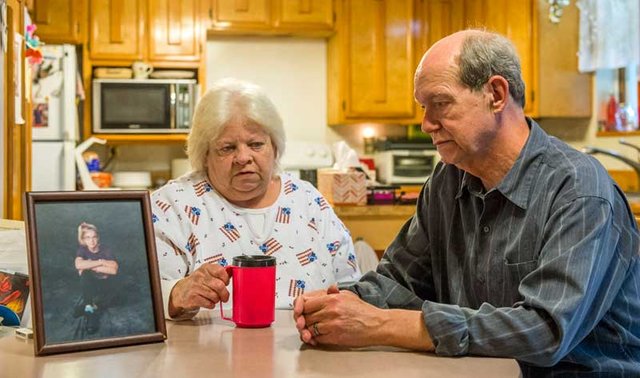
‘WE COULDN’T STOP HER’
Dennis and Darlene Hedman felt helpless when their 13-year-old daughter called them from a payphone in September 1993, having just walked out of a drug treatment center in Spokane.
Her message to them that day: Don’t try to find me this time.
It was the first the Hedmans heard there was a problem with Becca’s new drug treatment program. The center where they’d dropped her off hadn’t told them she’d left, they said.
“She called us collect, and told us she was on the street, and don’t come looking for her,” Darlene Hedman recalled.
By then, Becca was 13, and known on the street as “Misty.” She was working as prostitute to fund her addiction to crack cocaine.
State law at the time didn’t allow parents to admit their children to drug treatment without the child’s consent unless a child was 12 or younger. Nor did the law explicitly require individuals or youth shelters to notify parents if a runaway child came or left.
After Becca first ran away from her parents’ home in Tacoma at the age of 12, she ended up in the custody of law enforcement or the state Department of Social and Health Services at least seven times, Dennis Hedman said, “and we didn’t even get a phone call.”
“We couldn’t stop her from running away,” Darlene Hedman said in a recent interview. “That’s what got us into the Becca Bill — we had no parenting rights.”
A month after Becca called her parents from the Spokane payphone, she was dead.
A man who paid Becca $50 for sex demanded his money back afterward, and she refused, prosecutors said. The man then clubbed her six times in the head with a baseball bat, cracking her skull, and dumped her nude body near the Spokane River.
When he confessed, John Medlock didn’t give prosecutors much of a reason for killing the 13-year-old girl, except to say the sex wasn’t very good.
In 1995, a jury found Medlock guilty of murdering Becca and sentenced him to 26 years in prison.
WHAT THE LAW DOES
Less than a month after Becca’s death, her parents gathered around their dining room table and wrote down on a legal pad all the things they thought could have helped save their daughter.
They joined other parents and took that list to Olympia, along with a photo of Becca from the year before she ran away. Together, they pushed lawmakers to grant parents more authority over their runaway kids.
Lawmakers responded by passing the Becca Bill in 1995. The new law did several things. For one, it established that anyone providing shelter to a runaway must notify police or the child’s parents.
It then clarified procedures by which parents could file a court petition to get their minor child to abide by certain rules, such as not running away or staying clean of alcohol and drugs. Kids, too, could file a petition to seek an out-of-home placement if they had problems at home.
Significantly, the Becca Bill also required school districts to file truancy petitions in juvenile court if a student has seven unexcused absences in a month or 10 in a year.
Judges can order the children who appear before them for truancy or at-risk youth petitions to follow rules such as attending school every day, submitting to drug and alcohol testing, or coming home every day by a certain time.
If a child doesn’t comply with the court’s order, the judge can impose sanctions, including up to seven days in juvenile detention.
After the Becca Bill became law, judges quickly began using detention to push truant and runaway kids to comply with court orders.
In 1994, the year before the law was passed, judges in Washington placed minors in juvenile detention for noncriminal offenses 222 times, according to the state Office of Juvenile Justice. By 1997, that number had risen to 2,053 — an increase of 825 percent.
In recent years, judges in Washington have used detention as a sanction slightly more often for runaways than for truants.
Of the 2,812 times Washington judges placed youth status offenders in detention in 2013, 47 percent were related to violations of court orders in at-risk youth or runaway cases, while 42 percent were for truancy cases, according to the state Office of Juvenile Justice.
The rest of the detentions mainly involved children violating court orders in dependency cases, in which the state seeks to place children in foster care or remove them from a parent’s home.
Judge David Edwards talks with a truant youth in Grays Harbor County Superior Court in April. Grays Harbor County detains youths for noncriminal offenses, such as truancy or running away, more often than any other county in Washington state.
(Peter Haley, staff photographer.)
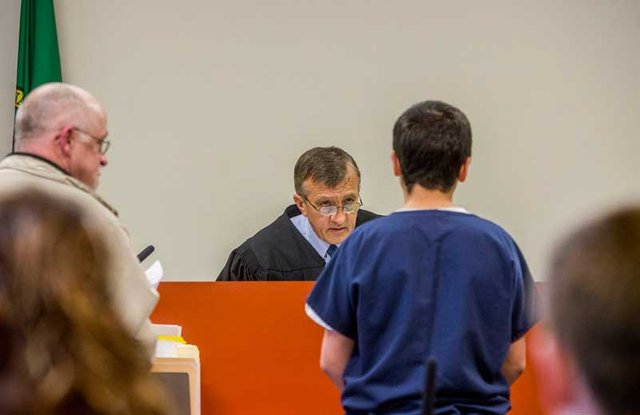
DOWNSIDES TO DETENTION
Many researchers and legal experts say that putting children in detention for noncriminal activity doesn’t usually improve their behavior and can actually make their problems worse.
According to a 2008 publication of the American Bar Association, detaining youth status offenders “increases the possibility of their engaging in antisocial behavior,” while also limiting their access to helpful interventions they might receive at home or out in the community.
Other researchers note that children who skip school or run away often have mental health problems or a history of abuse, problems difficult to deal with in a detention facility.
“They need care, treatment, and services — not confinement — to address the underlying causes of their troubling behavior, and to prevent deeper and more costly entanglement in the juvenile or criminal justice systems,” according to a 2009 article that appeared in the Seattle Journal for Social Justice, an academic journal published by Seattle University’s School of Law.
But Hargrove said if lawmakers took away judges’ ability to impose detention on children who don’t obey a court order, the Becca Bill would be ineffective at getting students the help they need and keeping them out of the criminal justice system.
"The whole point is just to give the judges some way to enforce their attempt to get those kids back on the right track,” Hargrove said. “The intent is not to use it a lot.”
Hargrove said the state’s declining adult and youth crime rates since 1995 can be attributed largely to the Becca Bill, which he said has helped keep truants and runaways from becoming adult criminals. David Edwards, a Grays Harbor County Superior Court judge, also said he believes his use of detention for truants and at-risk kids is part of why juvenile crime rates in his county have dropped.
A 2010 analysis from the nonpartisan Washington State Institute for Public Policy found the Becca Bill had no statistically significant effect on high school enrollment in Washington. Nor could the institute determine whether the Becca Bill caused the state’s reduction in crime and juvenile arrests.
Peter Collins, an assistant professor of criminal justice at Seattle University, said that Washington’s declining crime rate in the past 20 years has been in line with nationwide trends. “There’s kind of a false attribution of the effect of incarceration on these rates,” he said.
“When we get into whether or not these sanctions have a deterrent effect, it’s actually the opposite of what we’re seeing: Either they don’t have an effect or they have a harmful effect,” Collins said.
If Pierce County juveniles don’t follow orders to attend school, they can be detained at Remann Hall for up to seven days.
(Peter Haley, staff photographer.)
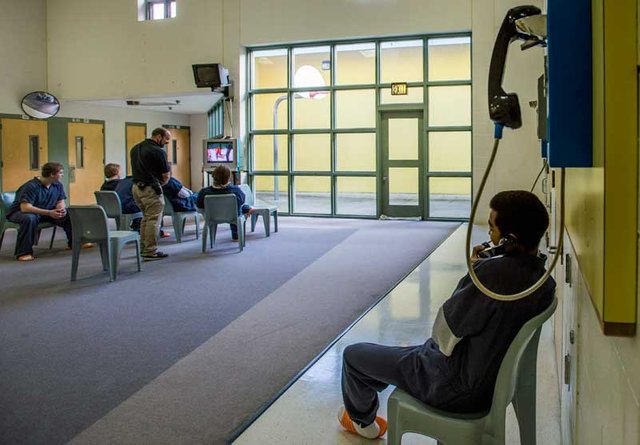
‘WE DON’T HAVE OTHER ALTERNATIVES’
Many juvenile justice officials agree that it’s bad practice to place kids who haven’t committed crimes alongside those who have been convicted of serious violent offenses.
“There is not one piece of research out there that suggests this is the right thing to do,” said TJ Bohl, the juvenile court administrator in Pierce County.
Yet detaining status offenders is still common practice in Washington, partly because many judges don’t feel they have adequate alternatives.
In a photo Hargrove likes to share, he and former Tacoma state Sen. Rosa Franklin stand in front of a flowchart, attempting in 1995 to explain the complexities of the Becca Bill to other Senate Democrats. In the image, Hargrove can be seen pointing to a large box at the beginning of the diagram that reads “CRC” — an abbreviation for “crisis residential center.”
The Becca Bill established secure crisis residential centers, or CRCs, as emergency shelters where police could bring runaway children after picking them up on the streets. The idea was to keep the children at a secure CRC for one to five days to assess what they needed — whether it be drug and alcohol counseling, mental health treatment or an out-of-home placement away from their parents.
Unlike detention facilities, secure CRCs generally don’t have locks on their doors and windows, but they are “staff-secure,” meaning that children are closely monitored and that building entrances are equipped with alarms that will notify staff if children walk out.
Many judges would like to be able to place children in secure CRCs instead of detention when they violate a court order in a truancy or at-risk youth case, said Stephen Warning, a Cowlitz County Superior Court judge. But most judges aren’t able to do that, he said, because that key element of Hargrove’s diagram — the CRC part — has become a missing link in most areas of the state.
“Certainly I agree putting these kids in detention is a concern,” Warning told a Senate committee in February. “But I noted when Sen. Hargrove’s flow chart for Becca got put up on the wall ... up in the upper left hand corner there’s a great big box that says CRC. Well, For 34 counties, that box is empty, and we don’t have that option available to us.”
Funding cuts, combined with a limited money for the centers to begin with, meant the number of secure crisis residential center beds last year dropped to 34 for the entire state, and those beds were available in only five of the state’s 39 counties: Chelan, King, Yakima, Clark and Clallam.
Prior to budget cuts in 2009, there were 60 secure CRC beds in nine locations throughout the state.
While an additional 32 crisis residential center beds are available at nonsecure facilities in Washington, only six counties have access to those.
In an ideal world, CRCs could also provide an alternative to a jail cell for runaways or at-risk-youth who are wanted under a warrant for failing to appear in court, said Bohl, the Pierce County juvenile court administrator.
Right now, a child who runs away and then misses a court hearing in an at-risk youth case may have a bench warrant issued for his or her arrest. In many counties, including large ones like Pierce, those children are taken directly to juvenile detention if they are picked up by police on a warrant and never redirected to a crisis residential center — primarily, because there isn’t one available.
Children picked up on warrants may remain in detention until they can appear in court the next business day for a contempt hearing. That could mean up to three days in detention if a child is brought in on a Friday night — and potentially more if a judge orders him or her back to detention as a sanction.
Bohl called that “a gap in our system.”
“One of the big challenges for Pierce County is we don’t have other alternatives,” said Bohl, who oversees the juvenile detention facility at Remann Hall in Tacoma. “The kid is either at home or in detention. There’s no stop-gap in between.”
Darlene Hedman said when she and her husband fought for the Becca Bill 20 years ago, jailing runaways was never what she wanted, but that’s what she sees happening today.
“There is no funding for kids, runaways, to get picked up and sent somewhere besides Remann Hall if they haven’t committed a crime,” she said. “We weren’t meaning to treat runaways as criminals, but that’s what it’s ended up being.”
In her apartment last week, Stacia Ague reflects on the life-changing effects of having been incarcerated as a teenager after she ran away from her foster home. She is now involved in juvenile justice reform. (Peter Haley, staff photographer.)
In her apartment last week, Starcia Ague reflects on the negative effects of having been incarcerated as a teenager after she ran away from her foster home. She is now involved in juvenile justice reform.
(Peter Haley, staff photographer.)
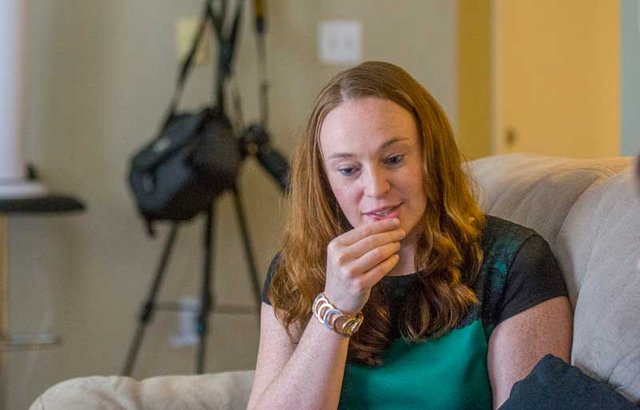
STARCIA’S STORY
For Starcia Ague, being placed in detention after she ran away from her foster home didn’t inspire her to start following the rules.
At 14, Ague was placed with a family in Lacey after being taken from her parents, who were involved in drug trafficking. But she didn’t feel welcome in her new foster home, she said; she felt the family treated her as a paycheck rather than a person.
So she ran.
Twice, Ague was picked up on a warrant and placed in detention until she could appear before a judge, she said. At the time, her only crime was running away.
Being placed in a jail cell made her feel as if she was a failure and a criminal, just like her parents, she said.
“Being behind the cell reinforced everything everyone had said: That I am going to be just like them,” said Ague, who is now 27.
“Back then, I didn’t understand why they were locking me up with a bunch of kids who were in there for criminal charges. It’s not like they separate them from the other youth,” she said.
Ague wasn’t scared straight by her brief stays in detention. Instead, a year later she ended up there on a more permanent basis after participating in a robbery gone wrong — an attempt to steal enough money to pay off a family debt, she said.
Looking back, Ague said she didn’t get the help she needed when she was detained as a runaway.
“There wasn’t like a counselor or someone to talk to. It wasn’t like there were services in there for the few days that you were in there,” she said. “It then becomes, ‘how do you transition back the community?’ And you have this label on you.”
“I felt like I didn’t really have a chance, that people already felt I was a bad kid, a bad seed.”
In March 1995, Democratic state Sen. Jim Hargrove, left, of Hoquiam explains to other Senate Democrats how runaways would be treated under the Becca Bill, which the Legislature aproved later that year. Joining him at right is former state Sen. Rosa Franklin, D-Tacoma. (Washington State Archives, Senate Photograph Collections.)
In March 1995, Democratic state Sen. Jim Hargrove, left, of Hoquiam explains to other Senate Democrats how runaways would be treated under the Becca Bill, which the Legislature approved later that year. Joining him at right is former state Sen. Rosa Franklin, D-Tacoma. (Washington State Archives, Senate Photograph Collections.)
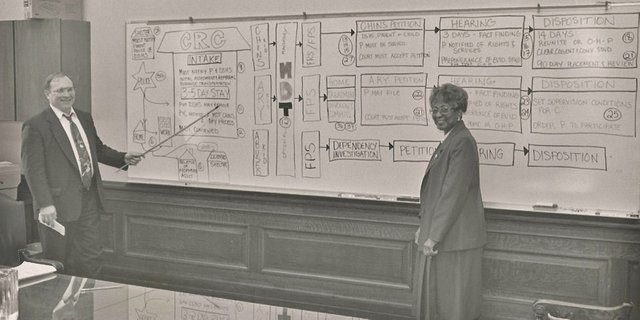
APPROACHES VARY BY COUNTY
The lack of crisis residential center beds is indicative of a larger problem in the Becca system: That many judges feel they have too few resources available to help kids who appear before them in truancy or at-risk youth cases.
Dennis Hedman said he feels the Becca Bill has largely been gutted due to inadequate funding for youth and family support services — and not just for the CRCs, but also for drug treatment and mental health counseling.
“The Becca Bill is like a 20-year-old watchdog, lying on your porch with four teeth,” he said. “It still has a couple of teeth left, but it’s not what it used to be.”
Jacqueline Jeske, a King County Superior Court commissioner, said she thinks Hargrove and others who developed the Becca Bill “were ahead of their time” by looking to provide troubled youth with counseling, drug treatment and other support services that could help them avoid becoming criminal offenders.
However, “that promise has never really been fulfilled with adequate and stable funding for interventions,” said Jeske, who presides over at-risk youth and truancy cases in the King County Juvenile Court.
Today, Jeske keeps a photo of Becca Hedman in the two courtrooms where she hears runaway and truancy cases in Seattle and Kent. She said the photo reminds her and other court staff of the tragic outcomes they are looking to prevent.
“I’m using it to honor the work that we do on her behalf, so there won’t be any more youth like her,” Jeske said.
But judges have different takes on the best way to keep young people safe and how often detention should be used for that purpose — especially for youth status offenders who haven’t committed a crime.
In population-dense King County, for instance, judges sent juvenile status offenders to detention 200 times in 2013, according to numbers from the state Office of Juvenile Justice.
Meanwhile, judges in rural Grays Harbor County detained status offenders 559 times the same year, even though the county has a much smaller youth population. Only about 7,000 children between the ages of 10 and 17 live in Grays Harbor County, compared with about 180,000 in King County.
Local counties also trail Grays Harbor in terms of how often they jail youth for noncriminal offenses. Pierce County detained juvenile status offenders 105 times in 2013, while Thurston County detained status offenders 89 times that year.
Juveniles in detention at Pierce County’s Remann Hall pass the time in a common area in April. Like many counties, Pierce County doesn’t separate youths who are detained for a noncriminal offense, such as truancy, from those who are in detention for a serious crime, such as murder or assault. (Peter Haley, staff photographer.)
Juveniles in detention at Pierce County’s Remann Hall pass the time in a common area in April. Like many counties, Pierce County doesn’t separate youths who are detained for a noncriminal offense, such as truancy, from those who are in detention for a serious crime, such as murder or assault. (Peter Haley, staff photographer.)

DETENTION AS A LAST RESORT
Superior Court Judge David Edwards, who presides over truancy and at-risk youth cases in Grays Harbor County, said often he will put a child in detention for a noncriminal violation “if I think it is the only safe place for him or her to be.”
Sometimes that means detaining children to protect them from abuse at home or to help get them treatment for an acute mental health condition that makes them a danger to themselves or others, he said.
“There is zero punishment involved in that decision, you understand,” Edwards said. “I’m doing it because I’m worried if I don’t, the child is going to get harmed.”
In truancy, at-risk and dependency cases, Edwards said he always starts by directing children and their parents to participate in counseling, anger control therapy, drug treatment or other services that could help them.
Things get more serious if children don’t follow the court-ordered plan, he said.
Edwards said he normally won’t put a child in detention the first time they disobey his order to stay at home, attend counseling, go to school or stay off drugs. But he will generally send truants and runaways to detention if they violate the court’s order a second time, he said.
“I always come back to the same point, and that is, ‘How can I help these kids become successful if I can’t teach them that there are consequences attached to their actions?’” Edwards said.
“I can order them to perform community service, but what if they don’t show up?” he asked. “If they don’t comply, I have to have the ability to compel compliance. And that’s where detention comes in.”
In King and Pierce counties, children may appear before a court commissioner after violating court orders multiple times and still not be placed in detention.
In a court case in March, Jeske was faced with a young man who frequently ran away from home or broke curfew, and had twice disobeyed her orders to attend school and stay clean and sober. At one point, the teenager had jumped out his bedroom window and ran away to avoid a court-ordered drug test.
Jeske didn’t put the teenager in detention. Instead, she told him to write a research paper on the job prospects for adults without a high school diploma.
She also gave him a choice for how he could purge his latest contempt order: attend a Seattle-based computer programming workshop on an upcoming Saturday or create a “vision board” — an art project in which he would depict his strengths, as well as what he sees as his weaknesses and the things that get him off track.
That project was to be carried out through a program known as Creative Justice, an art mentorship program that King County uses as an alternative to detention.
Grays Harbor County doesn’t have a community art program that can serve as an alternative to juvenile detention. Nor does the small county have access to electronic home monitoring for status offenders, an alternative to detention used in King County.
Yet Edwards said even when counties have those tools at their disposal, judges still need the option of using detention “as the ultimate method of compelling a student to do something.”
“I just don’t know how to get away from that,” he said.
Juveniles walk single file with hands behind their backs in the hallways of Remann Hall. (Peter Haley, staff
photographer.)
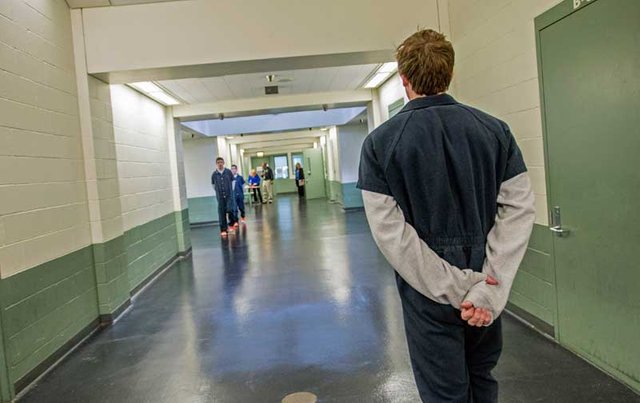
WASHINGTON AN OUTLIER
While Washington isn’t the only state that allows judges to place youth status offenders in lockup, judges here appear to use that option more than anywhere else.
Although federal law generally prohibits detention of juveniles for noncriminal offenses, it makes an exception for when youth violate a direct order from a judge.
Nationwide, 26 states used the valid court order exception to detain juvenile status offenders in 2011, while another 23 states did not, according to the most recent data from the federal Office of Juvenile Justice and Delinquency Prevention. Judges throughout the United States sent juvenile status offenders to detention for violating court orders about 7,400 times that year, with Washington accounting for more than one-third of those instances.
Why are Washington’s numbers so high? Naomi Smoot, senior policy associate at the Coalition for Juvenile Justice in Washington, D.C., said some other states have stricter laws in place that ban detention for juveniles who haven’t committed criminal acts, even if a child is in contempt of court.
Additionally, judges in other states may be more likely to choose sanctions other than detention for children who violate court orders in noncriminal cases, Smoot said.
Yet even in states where detaining juveniles for non-crimes is allowed, most states don’t have a law in place like the Becca Bill that automatically triggers a court process after a certain number of missed school days.
A 2010 analysis by the Washington Institute for Public Policy found that of 43 states surveyed, only four — Washington, Nebraska, Oklahoma and Texas — required school districts to initiate a court case after a specified number of school absences.
Darneille, the senator from Tacoma, says the automatic process of sending kids to court for truancy is one reason Washington’s use of court orders to detain juvenile status offenders is so high.
This year, Darneille proposed eliminating juvenile detention as one of the potential sanctions for students who violate court orders in truancy cases. Her bill failed to advance in the Legislature.
Hargrove said Washington still doesn’t treat truancy as harshly as some states. Wyoming and Texas, for instance, charge truant students or their parents with a criminal misdemeanor in adult court. The federal Office of Juvenile Justice and Delinquency Prevention hasn’t tracked how often juveniles in Wyoming and Texas are jailed in those cases.
Things are changing in Texas, however. In June, Texas Gov. Greg Abbott signed into law a measure that will decriminalize truancy in the Lone Star state. The new law will take effect Sept. 1.
Juveniles rest and watch television at Remann Hall. (Peter Haley, staff photographer.)
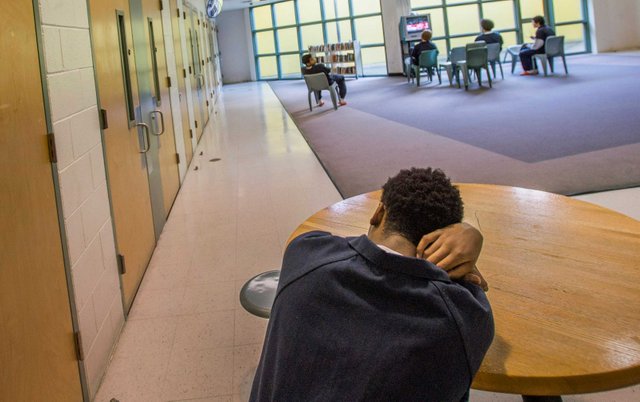
BECCA’S LEGACY
This year, Becca Hedman would have turned 35.
Her parents — now retired and living on South Hill — raised four other children. They proudly talk of their 16 grandchildren and six great-grandchildren, photos of whom are displayed throughout their home.
Their other legacy, the Becca Bill, they speak of with some regret.
“It’s not anywhere near the concept of the first Becca Bill, and nowhere near what anyone who worked on that was envisioning,” Darlene Hedman said.
Still, Jeske, the King County court commissioner, said she thinks judges throughout the state are trying to carry out the Hedmans’ vision — even if they struggle at times to find the resources to do so.
“I’m sure they hoped when they sought Sen. Hargrove’s help to never see another child lost like their child was lost,” Jeske said. “We’re trying to do the same thing ... trying to help families and connect them to meaningful interventions.”
Becca’s mother questions whether detention needs to be a part of that system, though.
“If they are running away, I don’t think it’s a crime to run away,” Darlene Hedman said. “I think it’s a cry for help to run away. And you don’t help them by putting them behind bars.”
Ague, the former runaway, agrees. Having received a gubernatorial pardon for the crimes she committed as a teenager, she is now the recipient of a national fellowship, working with the state Department of Social and Health Services to advance juvenile justice reforms.
“When you go through that process, it is for sure dehumanizing on so many levels,” Ague said. “The second a kid is being strip searched or has handcuffs on them for skipping school or running away, I don’t think we’re doing those kids any justice.”
Melissa Santos: 360-357-0209
COMMENTS
Guide to Preventing Truancy and
Understanding the “Becca Bill”
Truancy In our state, the law requires that children ages 6 to 17 who are enrolled in public schools, attend school
Monday through Friday, unless there is a good reason for being absent. In this case the parent or legal
guardian must excuse the absence by notifying the school. When students miss school and their parents have not excused the absence, they can be considered truant. Truancy is defined as being absent from school or from the majority of a student’s classes without a valid excuse.
School districts around the state have different rules and regulations about student attendance and how
parents should excuse absences. Be sure to read the attendance policies in your school district and
discuss them with your student.
The Becca Bill
The “Becca Bill” (SB 5439) is our state’s truancy law. It is intended to stop truancy before it becomes a
problem. Schools and families should work together as a team to ensure school attendance and student
safety. However, if a student has unexcused absences, this law requires that schools and school districts
take the following actions:
One (1) unexcused absence. The school must inform the parent when there is one unexcused
absence. This is often done by a phone call home.Two (2) unexcused absences. After the second unexcused absence, the school is required to
schedule a meeting with the parent/legal guardian and student to discuss the causes of the
unexcused absences and find solutions to prevent further absences. This is a team effort.Five (5) unexcused absences within 30 days. The school must enter into a written truancy
agreement with the family, where the parent, student and school agree on the necessary steps
to resolve the student’s attendance problem.Seven (7) unexcused absences during a month or at the tenth (10th) unexcused absence
within a school year. The school district will file a petition in juvenile court to order the student
to attend school. If this court order is violated, the court will call for a Contempt Hearing and the
student could be ordered to do community service or spend time in juvenile detention. The
parent may be fined up to $25.00 for each day of unexcused absence.
The school district may also refer the family to a “Community Truancy Board” if there is one in
the community. A Truancy Board is a group of citizens who help resolve truancy cases away
from the court.
Schools must send the student a notice of the truancy court petition by certified mail with return
receipt or by in-person delivery. The petition includes many important dates and deadlines that
must not be missed by the student and the family. A student and/or parents can be represented
by a lawyer in truancy court.
Preventing Truancy
Student safety and academic progress are important to both parents and educators. Here are some tips
to prevent absences:
Communicate with your student frequently
Talk about family expectations regarding school attendance.
Discuss family expectations for earning a high school diploma.
Praise positive behaviors and achievements in school.
Look for attitudes from your youth that indicate unhappiness with school or fear of attending
school.
Listen to what they say and ask questions.
Communicate with your school frequently
Ask the school about their policy and procedures on excusing absences from school.
Respond quickly when the school notifies you of an unexcused absence.
Learn how you can check your student’s attendance.
Immediately address issues of concern about your student with the school. Start with the
teacher or counselor.
If you feel your district’s truancy or discipline procedures were not addressed properly, inquire
about your district’s appeal process.
If you feel your school district policies are inadequate, speak with the Superintendent and
school board members.
Get more help when you need it
Go to the Education Ombudsman website at www.waparentslearn.org to read the Basic
Education Rights manual, Section VI.
If you have difficulties with the school in resolving truancy issues contact:
The Office of the Education Ombudsman toll-free at1-866-297-2597
or the Washington School Safety Center at 360-725-6044 or [email protected].
http://www.k12.wa.us/GATE/Truancy/pubdocs/Becca/BeccaBillinfoforparents.pdf
...
A photo of Becca Hedman at age 12, the year before she ran away and was murdered in 1993. courtesy Hedman family Courtesy Hedman family

Medlock Gets 26-Year Term In Girl’s Death Rebecca Hedman’s Murderer Is Sentenced

A Spokane man who killed a 13-year-old prostitute was sentenced to 26 years in prison Wednesday, concluding a case that drew attention to street children and ultimately led to new state laws.
When John Medlock bludgeoned Rebecca Hedman with a baseball bat two years ago, he also struck a nerve in the public consciousness. Concerns about teen runaways prompted the state Legislature to pass the Becca Bill this year, giving parents more control over their children.
Hedman ran away from her Tacoma home when she was 12 and wound up on Spokane streets, selling her body to support her crack cocaine addiction.
By giving children over 12 the right to make their own decisions, state law restricted her parents’ efforts to bring her home.
Medlock, 35, was convicted of first-degree murder May 18.
“I can live with the sentence he got today,” said Dennis Hedman, the victim’s father. “I still feel empty but I don’t feel depressed anymore. Things are right now.”
Medlock never explained why he cracked Hedman’s skull on Oct. 17, 1993, other than to say that the sex hadn’t been very good. Prosecutors said Medlock wanted his $50 back and the girl refused.
That’s when the normally quiet, law-abiding defendant hit Hedman six times from behind while she pulled on her jeans. Medlock also tried to strangle her, said the doctor who performed her autopsy.
Deputy Prosecutor Steve Kinn asked for an exceptional 40-year sentence, saying the crime was particularly cruel and that Hedman’s age made her vulnerable.
He also said after the murder, Medlock put the girl’s naked body in the bathtub at his motel room and took a nap. Hours later, he wrapped her in a wool blanket and dumped her along the banks of the Spokane River. Then he left town.
“He was not remorseful,” Kinn said.
Defense attorney John Muenster, however, said his client was described repeatedly by police as “quiet, polite, subdued and remorseful” after his arrest. He was also suicidal.
“He has a conscience powerful enough to drive him to suicide,” Muenster said. “And he confessed and cooperated with authorities. If he hadn’t, he never would have been arrested, never would have been charged, never would have been convicted.”
Medlock smiled, leaned forward in his chair and sipped water from a paper cup while the lawyers talked. When Kinn mentioned details of the killing, Medlock looked down and wrote on a legal pad.
His attorney asked for a 20-year sentence, the lowest end of the standard range for first-degree murder. Superior Court Judge James Murphy agreed Medlock showed remorse and noted he had no prior criminal record.
Murphy also acknowledged police had no leads after finding Hedman’s body. If Medlock hadn’t confessed to authorities in Port Moody, British Columbia, the case may not have been solved, he said.
Murphy sentenced Medlock to 320 months in prison, the highest end of the standard range.
“Deliberate cruelty exists whenever someone kills another human being,” Murphy said. “You have to be cruel.”
After the sentencing, Dennis Hedman waved goodbye as Medlock was handcuffed and led from court.
“It is finally feeling like it’s over,” he said.
Muenster said he is planning an appeal.
...
@familyprotection was started approximately 3 months ago. If you are concerned about where these funds are going, please take the time to read this post:
We are Family Protection, Keeping Families Safe, Together.
@markwhittam grew up in the care of CPS and then many years later he and his family had to flee their country under threats from the state to take their child because they home schooled.
Linda, @canadian-coconut, started @familyprotection because she has helped several families who have been torn apart at the hands of the legal kidnappers aka. Child Protection Services.
We are Family Protection, Keeping Families Safe, Together.
...
It is up to us as a Community to uncover the truth and spread this truth worldwide!
If you or someone you know have children that are now wards of the state and/or government, we encourage you to share your story. If you are an underage youth caught up in this insane cycle of abuse and control..Please share your story..If you have friends in abusive situations..Please have them share their story. We here at steemit.com have caring people that that are willing to help you in anyway we can.
If you wish to donate in support of this project, please do so by sending your donations in the form of Steem, Steem Power and or SBD to @familyprotection
Show your support for @familyprotection, @markwhittam, and @canadian-coconut by visiting their blogs, leaving comments revelent to this most worthy cause, upvoting and resteeming as many of these posts as you feel drawn to do. Please read this post prior to using the @familyprotection tag on any of your posts!
...
"Let the things break your heart that break the heart of God!"
...steemit posts in support of @familyprotection by @thethreehugs...
My life as a Juvenile Detention Officer.."Keep em Calm - Keep em Drugged!" .. Rebecca's Story..
My life as a Juvenile Detention Officer .. Pregnant Teens in Prison .. Janet's Story
Mandatory-dna-testing-for-all-youth-in-the-system
Coming to Terms with Alcohol, Drugs and Sex
https://steemit.com/family/@thethreehugs/coming-to-terms-with-alcohol-drugs-and-sex
My Wish for You! In Support of the "Victims"
My life as a Juvenile Detention Officer...A series of True Stories of Abuse of Children (Introduction)
My life as a Juvenile Detention Officer...A series of True Stories of Abuse of Children - Maria (Part 1)
My life as a Juvenile Detention Officer...A series of True Stories of Abuse of Children - Maria (Part 2)
My life as a Juvenile Detention Officer...A series of True Stories of Abuse of Children - Tanisha - From The Cradle to The Grave
What are the three things that cannot remain hidden?
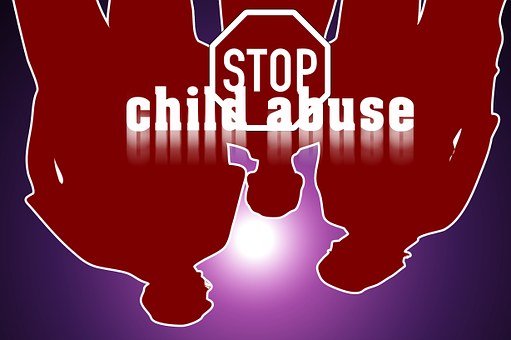
photos from pixabay.com
...

...
MAHALO FOR YOUR SUPPORT!!
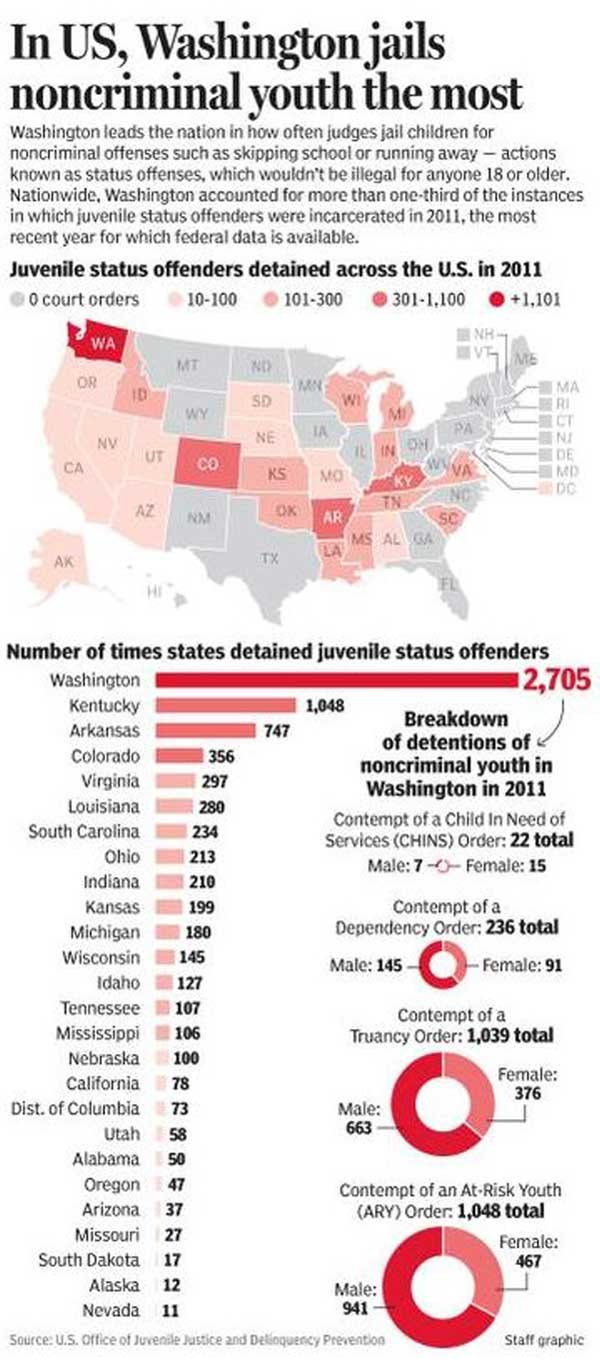
I found the story overwhelming, especially as they end up with someone's life and apparently there are no severe consequences, usually boys subjected to abuse resort to drugs, prostitution and alcohol to find a safe harbor
Yes, that seems to be the case when it involves kids. It's like their lives don't matter.